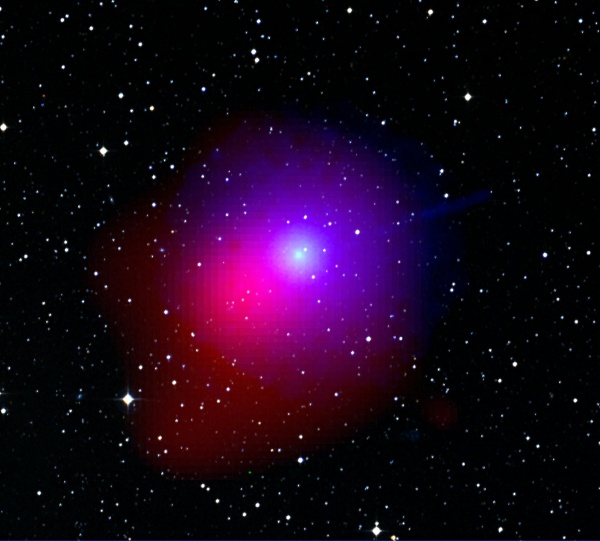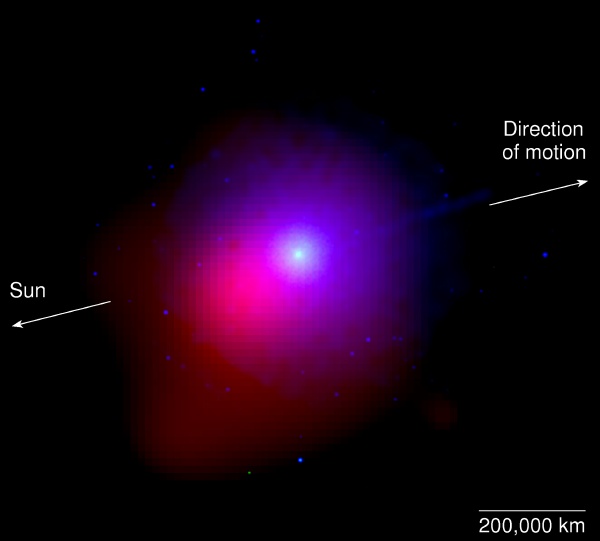A comet is a clump of frozen gases mixed with dust. These "dirty snowballs" cast off gas and dust whenever they venture near the sun. Comet Lulin, which is formally known as C/2007 N3, was discovered last year by astronomers at Taiwan's Lulin Observatory. The comet is now faintly visible from a dark site. Lulin will pass closest to Earth - 38 million miles, or about 160 times farther than the moon - on February 24.
The team is studying the comet to find out more about its chemistry and to gather clues about the origin of comets and the solar system. Swift is a NASA mission in collaboration with the Science and Technology Facilities Council (STFC) in the UK and the Italian Space Agency (ASI).
“Swift is the ideal spacecraft with which to observe this comet”, said Jenny Carter from the University of Leicester and lead investigator of the team studying the Lulin comet. "We won't be able to send a space probe to Lulin, but Swift is giving us some of the information we would get from just such a mission."

Comet Lulin was passing through the constellation Libra when Swift imaged it. This view merges the Swift data with a Digital Sky Survey image of the star field. Credit: NASA/Swift/Univ. of Leicester/DSS (STScI, AURUA)/Bodewits et al.
Dr Julian Osborne, leader of the Swift project at Leicester, said “The wonderful ease of scheduling of Swift and its joint UV and X-ray capability make Swift the observatory of choice for observations like these.”
"The comet is releasing a great amount of gas, which makes it an ideal target for X-ray observations," said Andrew Read, also at Leicester.
"The comet is quite active," said team member Dennis Bodewits, from the Goddard Space Flight Center. "The UVOT data show that Lulin was shedding nearly 800 gallons of water each second." That's enough to fill an Olympic-size swimming pool in less than 15 minutes.
Swift can't see water directly. But ultraviolet light from the sun quickly breaks apart water molecules into hydrogen atoms and hydroxyl (OH) molecules. Swift's UVOT detects the hydroxyl molecules, and its images of Lulin reveal a hydroxyl cloud spanning nearly 250,000 miles, or slightly greater than the distance between Earth and the moon.

This image of Comet Lulin taken Jan. 28 merges data acquired by Swift's Ultraviolet/Optical Telescope (blue and green) and X-Ray Telescope (red). At the time of the observation, the comet was 99.5 million miles from Earth and 115.3 million miles from the sun. Credit: NASA/Swift/Univ. of Leicester/Bodewits et al.
In the Swift images, the comet's tail extends off to the right. Solar radiation pushes icy grains away from the comet. As the grains gradually evaporate, they create a thin hydroxyl tail. Further from the comet, even the hydroxyl molecule succumbs to solar ultraviolet radiation. It breaks into its constituent oxygen and hydrogen atoms
This interaction, called charge exchange, results in X-rays from most comets when they pass within about three times Earth's distance from the sun. Because Lulin is so active, its atomic cloud is especially dense. As a result, the X-ray-emitting region extends far sunward of the comet.
"We are looking forward to future observations of Comet Lulin, when we hope to get better X-ray data to help us determine its makeup," noted Carter. "They will allow us to build up a more complete 3-D picture of the comet during its flight through the solar system."
Professor Keith Mason, Chief Executive of the Science and Technology Facilities Council (STFC), said, “Swift is an incredibly successful international project with a large degree of UK involvement. It continues to produce amazing results and has already recorded a wealth of information on gamma ray bursts. By using Swift’s cutting edge technology to look at this comet, we may also be able to gather a great deal of new information about comets.”






Comments